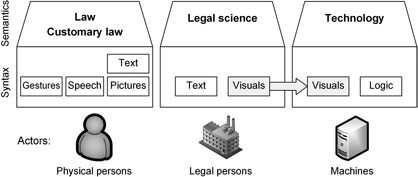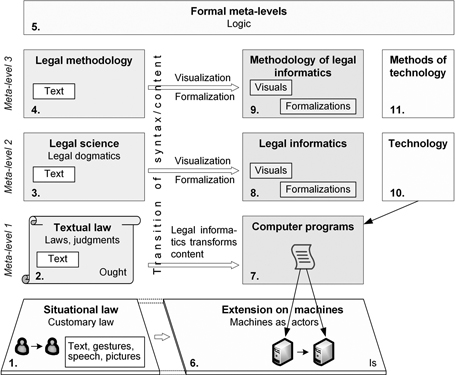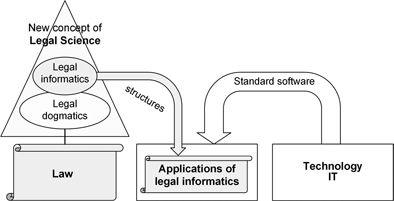Consider the evolutionary steps from customary law to modern law and then to technology (see Figure 1). This concerns the changeover from a text culture to a machine culture in law. With this changeover, the language changes, too. The language of the machine culture is the formal logic that is adequate for the machine, but it is not appropriate for people in their everyday language usage.

Figure 1: Visualization becomes a syntactical bridge from legal science to technology
By the term nontextual notations, we primarily mean legal visuals and formalizations that contribute to representing law in computers. The object to explore is the transformation of legal content and its syntax in the transition from the sphere of law to the sphere of machines. The transformation takes place from textual to symbolic–formal expressions.
The key concepts of interest in this paper are depicted in Figure 2. This figure serves as an outline. It is arranged in two columns: the first column is devoted to law, while the second is devoted to technology.

Figure 2: Legal content and its syntax are transformed in the transition from law to machines
This paper explores the link between the first column and the second column as shown in Figure 2. The object to explore is the transformation of legal content and its syntax in the transition from law (see Figure 2 elements 1 through 4) to technology (elements 6 through 9). The transformations may require multiple stages. For example, the transition from ‘Textual law’ (see Figure 2 element 2) to ‘Computer programs’ (element 7) also requires formalization, and not just ad hoc coding. The latter transition can be depicted with multi-arch bridge and is called multiphase transformation. This transformation comprises four stops: textual microcontent, symbolization/visualization, formalization, and computer program [Čyras/Lachmayer 2013].
2.
Emergence of nontextual notations ^
The following are short descriptions of the concepts shown in Figure 2.
1. Situational law (societal norms). In the real world, that is, the Is realm, people think in terms of roles and are governed primarily by the principle “roles, not rules.” People do not even know rules and paragraphs of the law. A person communicates information to a person. Customary law, for instance, is situational. Originally, customary law was determined by actions, gestures, speech acts, and symbols. This has essentially remained unchanged up to now.
2. Textual law (positive law, including legislation and case law). This corresponds to the Ought realm. Laws and judgments are produced textually. In real-world situations, ordinary people deal in terms of roles, whereas professional jurists think in terms of rules. Text dominates over a small proportion of pictures as in the Sachsenspiegel.
3. Legal science. Legal dogmatics comes in as a meta-level above the law. Legal science is expressed in texts. Legal commentaries, for example, are textual. People live in a literate culture. Text has dominated since the Middle Ages.
4. Legal methodology. This is also textual. The methods of legal logic, for example, are textual; see the works by Ota Weinberger, Ilmar Tammelo, Leo Reisinger, and Giovanni Sartor to name just a few.
5. Formal meta-levels. Logic and rhetoric are assigned to these.
Next comes the column of technology:
6. Extension of the Is world on machines. The Is extends on machines as actors. There are different machines, for example, computers and automated cars. The fields of “digital humanities” [Burdick et al. 2012] and “human digitalities” [Čyras/Lachmayer 2020] are also assigned to this level.
7. Computer programs. They are precise and formal. Computer programs are executed on machines.
8. Legal informatics. Legal informatics is understood as a hyphenated science and yet also as part of jurisprudence. It is essential in the link between law and technology.
9. Methodology of legal informatics. This is also understood as a hyphenated science.
Two more elements can be added:
10. Technology. Computer programs are built according to software technologies.
11. Methodology of technology. This is a meta-level above technology.
The discourse on legal theory of the 1960s was determined by Hans Kelsen’s second edition of the Pure Theory of Law (PTL, for short) (see Reine Rechtslehre) and its 1967 English translation [Kelsen 1967]. Nevertheless, a new position had already emerged. Based on Georg Henrik von Wright’s work Deontic Logic (1951), the formal consideration of law increased. Especially since the 1970s, this view in the form of “legal logic” has become the definitive legal–theoretical paradigm. The scientific concern was to gain a completely new access to law by transforming legal content into a formal language or a notation. This was the beginning of a machine culture in law, because in this context, textual language is no longer sufficient.
Legal informatics as a part of legal science. Technologists may think that legal applications can be implemented with about 80% standard software, such as database management systems (see Figure 3). However, the remaining 20% would need legal informatics. This share ensures better functioning of the applications.

Figure 3: Legal informatics as a part of legal science [Čyras/Lachmayer 2022]
Legal dogmatics contributes to the interpretation of legal texts and to computer applications. Technologists, however, may expect that standard software skills are enough. We propose supplementing legal dogmatics with legal informatics to form a new conception of legal science. Legal informatics contributes to the interpretation of legal texts and the structuring or representation of legal knowledge. Legal informatics offers a variety of methods, for instance, formal notation, structural analysis, modeling methods, documentation, metadata, searches and citing. The inclusion of legal informatics in legal science (for the purpose of structuring legal knowledge) constitutes a new concept for legal informatics. The paradigm shift is that legal informatics becomes a part of legal science – not a part of informatics. Legal informatics renews legal dogmatics that were, until now, very textual. Besides textual notation, legal informatics brings in graphical notation.
A practical issue is the impact of technology on society. Technology shapes the law. Legal informatics also starts to shape the social reality. We conclude that through legal informatics, technologies have an impact that was previously owned by the law.
3.
Transition of content and syntax ^
Legal content and its syntax are transformed through the processes of visualization and formalization when transited from the column of law to the column of technology (see Figure 2). As a result, legal visuals and formalizations emerge in the column of technology. The addressees of the visualization and formalization processes are distinct. The human is the addressee of visualization, whereas the computer is the main addressee of formalization. Visuals serve humans as illustrative material and depict complex relationships in the field, whereas formalizations are based on logic and represent the transformed legal content in computer programs.
This paper presents a bridge theory: text is transformed to nontextual notations, such as visuals and formalizations. In actuality multiple bridges result; see multiple arrows in Figure 2 from element 2 to element 7, from 3 to 8, and from 4 to 9, correspondingly. Multiple bridges correspond to different functions. Through the transformation of syntax, especially in legal informatics, new mental functions are enabled. The structuring of the bridges provides, first, humans with more complete views and, second, computers with more precise representations. It can be said that the second is a consequence of the first.
Strict and non-strict visualizations. Currently, several types of visualization have emerged. The spectrum ranges from automatic visualizations, in which legal terms are arranged by a computer like the stars of a galaxy, to situational drawings and metaphors for robots.
The advantage of a non-strict visualization lies in the fact that the subject is not always distinguished and strictly structured. Notations for such visuals are usually more open and thematically more elastic than logical notations. For the most part, the syntax is not set and can be changed to suit the topic. This is an advantage in case other notations are not sufficient to represent newly occurring structures. In such cases, an experimental notation is needed, and it can be quite intuitive in its origin. The visualizations probably have two components: an intuitive view and a rational order in a regular syntax.
Non-strict visualization need not be an advantage, for example, when the aim is to interpret a text and give its intended precise meaning. Therefore the task has to be considered.
A new phase in legal visualization. A new phase has begun with the emergence of legal logic and legal informatics. Although there were earlier legal visualizations, such as the illustrated manuscripts for the Sachsenspiegel, formally conceived notations have been emphasized to a greater extent since the 1970s. Legal informatics allow legal content to be formally structured, and this is a more powerful starting point for computer applications. Legal informatics affects the hitherto traditionally textual jurisprudence, in the sense of being a syntactical paradigm shift on the meta-level. Society is influenced by trends related to information and communication technologies, such as “digital humanities,” “human digitalities,” and the “code is law” [Lessig 2006] formula.
In the positive law of advanced cultures, legal texts are added, such as laws and legal adaptations. The emerging legal visualization brings with it a change in syntax. First, it is able to create an expanded understanding of the abstract structures of law. Second, formal visualizations form a bridge to the logical structuring of legal semantics, that, in turn, is a prerequisite for the application of machine culture in law. To make this application effective, the requirements of multisensory law must be observed; see Colette Brunschwig’s work [Brunschwig 2018].
The path to a methodological paradigm shift leads through abstraction, the results of which can then be applied to situations. The starting point is the situational forms of appearance (images); but from the professional point of view, it is the structures (universalia in re) that go further. Finally, it is categorical thinking that grants access to the abstract. In gaining this access, several affine patterns can be assumed, including categorical ones. From here, further access can be obtained to legal informatics, to the legal thesaurus; see, for example, the European Union’s terminology database IATE (Interactive Terminology for Europe)2 and legal ontologies [Sartor et al. 2011].
A normative structuring of situations takes place in everyday life as well as in virtual worlds, albeit sometimes with different rules. Augmented reality supplemented with virtual reality represents an area of synthesis [Muff et al. 2022]. In all situational areas, metamodeling is of particular methodological importance. In these virtual areas, top-down learning can be integrated with bottom-up learning in a previously unknown way.
4.
Image – Structure – Categories – Ontologies ^
The medieval discourse on universalia is a way to understand the framing of legal ontologies. Abstraction is a guide from images via structures toward categories (see Figure 4).

Figure 4: The way from image to structure and then to categories is through abstraction
[Čyras/Lachmayer 2022]
A starting point is the situational experience, containing persons, things, space, and time – the four dimensions of legal validity (“Geltungsbereiche”) [Nawiasky 1953]. We live in a culture of images. Painters, artists, and the media constitute, perform, and manage images. Legal texts and judicial hearings are external appearances. They are images of the legal system much like the behavior of traffic on the roads.
However, a professional point of view opens an understanding of internal structures. For instance, physicians understand the body and illness, lawyers and judges know legal semantics, and scholars see the structures beyond the images. However, not all of these professionals reach as far as the formal categories of their knowledge, as is done in jurisprudence.
The goal of this study is to find a methodological bridge from legal theory to legal informatics (see Figure 5). This bridge consists of multiple arches, and legal visualization forms one of these arches. From legal terms (categories), there is also a further path – to legal thesauri and ontologies [Guarino et al. 2009]. This path is categories – ontologies – augmented legal virtual situations. Legal categories (as part of legal theory) lead to legal ontologies (within legal informatics). The target of these efforts could be augmented legal virtual situations. Legal ontologies are the next step in constituting meta-levels. From a dynamic point of view, it is not only the logical structure that is relevant but also affine patterns.

Figure 5: A bridge from legal visualization to legal informatics [Čyras/Lachmayer 2022]
To sum up, visualizations help to bridge the gap between the textuality of law and logico-technical notations.
5.
References ^
Brunschwig, Colette, Perspektiven einer digitalen Rechtswissenschaft: Visualisierung, Audiovisualisierung und Multisensorisierung. Perspectives of Digital Law: Visualization, Audiovisualization, and Multi-Sensorization, Max Planck Institute for European legal history research paper series no. 2018-03, Frankfurt am Main 2018. Available at https://ssrn.com/abstract=3126043.
Burdick, Anne/Drucker, Johanna/Lunenfeld, Peter/Presner, Todd/Schnapp, Jeffrey, Digital Humanities, MIT Press, Cambridge, MA 2012.
Čyras, Vytautas/Lachmayer, Friedrich, Multiphase Transformation in the Legal Text-to-Program Approach. In: Sturm, Fritz/Thomas, Philip/ Otto, Jochen/Mori, Hikaru (Eds.), Liber Amicorum Guido Tsuno, Vico Verlag, Frankfurt am Main 2013, pp. 57–70. Available at SSRN: https://ssrn.com/abstract=2632045.
Čyras, Vytautas/Lachmayer, Friedrich, Legal Visualisation in the Digital Age: From Textual Law Towards Human Digitalities. In: Hötzendorfer, Walter/Tschohl, Christof/Kummer, Franz (Eds.), International Trends in Legal Informatics: Festschrift for Erich Schweighofer, Editions Weblaw, Bern 2020, pp. 61–76.
Čyras, Vytautas/Lachmayer, Friedrich, Towards Legal Visualization. In: Buchner, Benedikt/Petri, Thomas (Eds.), Festschrift for Marie-Theres Tinnefeld. Mohr Siebeck Verlag, Tübingen 2022 (in press).
Guarino, Nicola/Oberle, Daniel/Staab, Steffen, What is an Ontology? In: Staab, Steffen/Studer, Rudi (Eds.), Handbook on Ontologies, Springer, Berlin, Heidelberg 2009, pp. 1–17. https://doi.org/10.1007/978-3-540-92673-3_0.
Lessig, Lawrence, Code Version 2.0, Basic Books, New York, NY 2006.
Muff, Fabian/Fill, Hans-Georg/Kahlig, Eleonora/Kahlig, Wolfgang, Kontextabhängige Rechtsvisualisierung mit Augmented Reality: Towards Context Dependent Legal Visualizations, HMD Praxis der Wirtschaftsinformatik, 2022, 59, pp. 92–109. https://doi.org/10.1365/s40702-021-00832-x.
Nawiasky, Hans, Die Stellung der Einzelperson im Völkerrecht: Eine grundsätzliche Betrachtung, Die Friedens-Warte, 1953, Issue 55, pp. 235–243. https://www.jstor.org/stable/23777520.
Sartor, Giovanni/Casanovas, Pompeu/Biasiotti, Maria Angela/Fernández-Barrera, Meritxell (Eds.), Approaches to Legal Ontologies. Law, Governance and Technology Series 1. Springer, Dordrecht 2011.
- 1 This extends the article Čyras/Lachmayer, Towards Legal Visualization. In: Buchner, Benedikt/Petri, Thomas (Eds.), Informelle Menschenrechte und digitale Gesellschaft. Mohr Siebeck, Tübingen 2023, pp. 165–173.
- 2 https://iate.europa.eu/.





